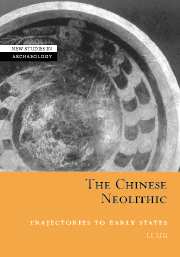Book contents
- Frontmatter
- Contents
- List of illustrations
- List of tables
- Preface
- Cambridge Cultural Social Studies
- 1 Setting the scene
- 2 The changing environmental contexts of China's first complex societies
- 3 Household subsistence and ritual
- 4 Spatial organization and social relations in communities
- 5 Community burial patterns
- 6 Development and decline of complex societies in the Central Plains
- 7 Development and decline of social complexity beyond the Central Plains
- 8 Trajectories toward early states
- 9 Reconstructing social processes
- Notes
- Appendixes
- References
- Index
7 - Development and decline of social complexity beyond the Central Plains
Published online by Cambridge University Press: 22 September 2009
- Frontmatter
- Contents
- List of illustrations
- List of tables
- Preface
- Cambridge Cultural Social Studies
- 1 Setting the scene
- 2 The changing environmental contexts of China's first complex societies
- 3 Household subsistence and ritual
- 4 Spatial organization and social relations in communities
- 5 Community burial patterns
- 6 Development and decline of complex societies in the Central Plains
- 7 Development and decline of social complexity beyond the Central Plains
- 8 Trajectories toward early states
- 9 Reconstructing social processes
- Notes
- Appendixes
- References
- Index
Summary
From the perspective of historical geography, it now can be argued that, during the Three Dynasties and predynastic period, there were two [cultural] systems [in China], one in the east and one in the west. These two systems confronted, competed, and interacted with each other, and then developed culturally. The Yi and Shang belonged to the eastern system, while the Xia and Zhou were the western system.
“Yi Xia dongxishou” Fu Sinian (1933)Introduction
The above statement made in the 1930s by Fu Sinian was based on traditional textual records rather than archaeological evidence. Whether or not these two assumed cultural systems existed during prehistory and the early dynastic period is questionable, since the texts referred to by Fu were written thousands of years after the Neolithic period. However, there were indeed differentiations in geographic configuration and material cultural traditions between the east and west regions along the Yellow River valley during the Neolithic period. This chapter examines the Longshan settlement patterns of two regions beyond the Central Plains, Shandong in the east and central Shaanxi in the west. Both regions witnessed the development of early complex societies, yet did not evolve into state-level societies through their own internal dynamics. It is hoped that the study of these cases will provide a deeper understanding of the processes which drove the development and decline of social complexity.
- Type
- Chapter
- Information
- The Chinese NeolithicTrajectories to Early States, pp. 192 - 222Publisher: Cambridge University PressPrint publication year: 2005



